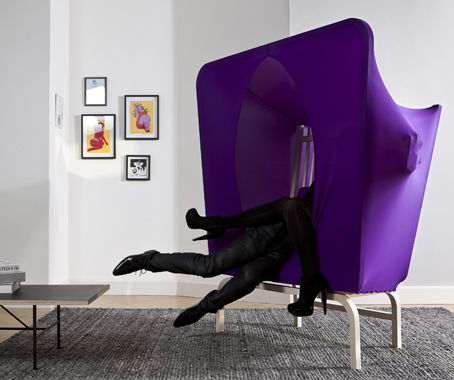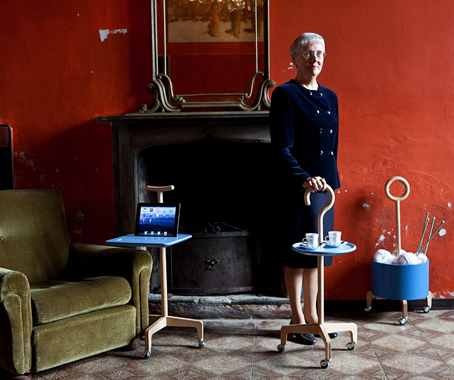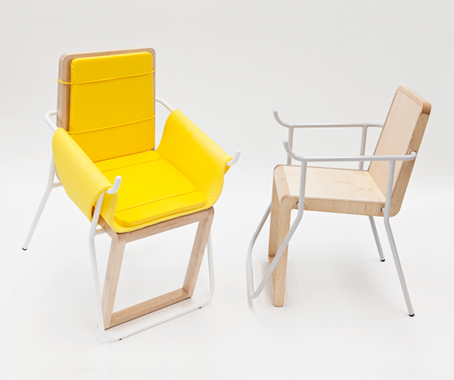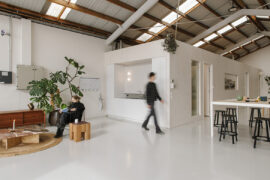International borders and categorical boundaries are no hindrance to the rich exploratory works of Lanzavecchia + Wai
November 28th, 2012
The objects designed by Francesca Lanzavecchia (Italy) and Hunn Wai (Singapore) have a way of holding your attention and making you think. It’s much like one’s encounter with a richly conceived artwork.

Streamline – 75% SLS AMG / Carpet from the Mercedes Benz Home Collection curated by Case da Abitare. Photo by Davide Farabegoli
“When we start a new project,” says Lanzavecchia, “we consider its ’surroundings’ – including history and rituals. We think laterally. We don’t just try to make an image; we communicate a message.”
For Lanzavecchia and Wai, being designers means being researchers, engineers, craftspeople, and storytellers all at once. They maintain an impressively rich creative and collaborative approach despite being based some 10,000 kilometres apart. Italian Lanzavecchia has a studio in Milan, while Wai works from his home country of Singapore.

Fragmented Cabinets 02. Photo by Patrick Toomey Neri
They come together about four times a year for intense month-long periods of product development. The rest of the time, they communicate via Skype, email, iMessage and Dropbox. “Our studio is open 24 hours!” quips Lanzavecchia.
The two minds met in the Netherlands at the Design Academy Eindhoven, where they achieved masters in design under the tutelage of Gijs Bakker. Their studio Lanzavecchia + Wai was officially established in 2009 during a 3-month residency at the Danish Art Workshops as part of the Time to Design – New Talent Award.

_Davide%20Farabegoli.jpg)
Spaziale Series – Our Chair
Their first collection was ’Spaziale Series: New Expressions of Skin and Structure’, a “family of organic domestic creatures” (such as a chair and shelves) that explore changeable material expressions in connection with their use. It was launched at the Salone del Mobile 2010 at Ventura Lambrate, Milan.
The series was a clear statement of the pair’s belief that products are extensions of the human being. “We’re really interested in the intimate bond that is created between the human body (and being) and objects,” says Lanzavecchia.
Indeed, function, emotion and cultural practices are given equal consideration in the development of their objects. Their divergent backgrounds provide all the more fodder for exploration.
“We try to use the contrast to generate energy and ideas,” suggests Wai. “Obviously we’re inherently different because of where we’re from and how we were brought up,” he continues. “And being a man and a woman – that’s probably the biggest difference!” adds Lanzavecchia.

Torque / Vase from the Mercedes Benz Home Collection curated by Case da Abitare
“But we have a chemistry when it comes to how we look at things,” says Wai. And it is a chemistry that has captured the attention of brands such as Mercedes Benz, Samsonite and Alcantara, which have engaged the pair with special commissions.
Galleries and museums have also requested special work, including MAXXI – the National Museum of the XXI Century Arts in Rome, where Lanzavecchia + Wai’s ’Home Sweet Car’ project has recently been displayed.

One Day in the Life of V.M. on Earth. Photo by Davide Farabegoli
Many of the duo’s objects occupy the boundary or overlap between design and art. ’One Day in the Life of V.M. on Earth’, for example, is a “space quilt” of woven Mylar strips. It plays with the American cultural tradition of reflecting a mosaic of a woman’s life in a quilt using swatches of fabric from memorable events.


The making of One Day in the Life of V.M. on Earth. Photos by Davide Farabegoli
Each strip of Mylar is hand stamped with the names of objects encountered, touched or used in the everyday rituals of a woman. Lanzavecchia + Wai describe it as “both the product of a private story and an artefact for the future.” This piece was recently acquired by the Museum of Art – Rhode Island School of Design, for their permanent collection.

Leone series 1. Photo by Daniel Peh
The ’Leone’ lights evolved from a collaboration with Singapore’s last remaining lion dance mask craftsman. The series brings the artistry of this rare Southeast Asian trade into the domestic space.
_Daniel%20Peh_2.jpg)
_Daniel%20Peh_3.jpg)
The making of Leone series 1. Photos by Daniel Peh
Comments Wai, “Sometimes the message can’t be mass produced. Be it design or art, it’s a matter of finding the most suitable avenue to walk down to deliver the message. It’s about how strong the format is.”

No Country for Old Men – Together Canes. Photo by Davide Farabegoli
The ’No Country for Old Men’ series of objects, meanwhile, has the potential for production at a significant scale. The series addresses mobility and other issues related to the ageing process, while bringing a level of desirability and “re-humanisation” to the genre of objects for the elderly.
.jpg)
No Country for Old Men – Monolight. Photo by Davide Farabegoli
’Together Canes’ are walking aids that support living habits as well as mobility. ’Monolight’ is a lamp that magnifies as well as illuminates. ’Assunta’ is a tilting chair that assists with standing up.


No Country for Old Men – Assunta. Photos by Davide Farabegoli
“We’re discussing production with several brands at the moment,” says Lanzavecchia. “Some of them are from the medical field; others are furniture brands.”
_Giorgio%20Fresi.jpg)
_Giorgio%20Fresi.jpg)
A Voyage in Lightness (store installation for Samsonite)
The pair has also ventured into the interior realm, with projects such as a store installation for Samsonite during the International Milan Design Week 2011. Titled ’A Voyage in Lightness’, it explored the concept of weightlessness via the changeable form of the suspended water droplet.
With connections to the galleries, producers and markets of Europe as well as those of Asia, Lanzavecchia + Wai straddle two worlds whose opportunities offer them immense potential. It’s surely a position that is envied by many of their contemporaries – on both continents.
On the crisis in Europe, Lanzavecchia offers a hopeful perspective. “At the end of the day, I hope this crisis will lead to a better way of consuming, and that consumption will be driven more by reflection and emotion rather than just by the will to own something.”
Lanzavecchia + Wai
lanzavecchia-wai.com
INDESIGN is on instagram
Follow @indesignlive
A searchable and comprehensive guide for specifying leading products and their suppliers
Keep up to date with the latest and greatest from our industry BFF's!

Rising above the new Sydney Metro Gadigal Station on Pitt Street, Investa’s Parkline Place is redefining the office property aesthetic.

CDK Stone’s Natasha Stengos takes us through its Alexandria Selection Centre, where stone choice becomes a sensory experience – from curated spaces, crafted details and a colour-organised selection floor.
Josep Patsi heads up the design team at Spanish lighting company Leds-C4. He shares his design process, inspiration and vision for the future of lighting with Indesignlive.
The internet never sleeps! Here's the stuff you might have missed

It’s designed for how you live, not just for how it looks.

Kiri Morgan, Director at Nightworks Studio, talks to us about the New Zealand practice’s very own new production space at Lawson St.